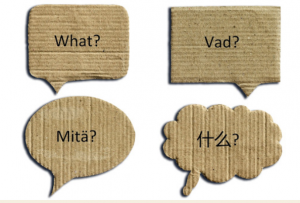Written by the Kontula-Gårdbacka Group
26.10.2020
I thought about what I was going to say the whole bus ride. I even looked some words up on Google translate and jotted down some notes. I walked into the classroom, my palms were sweating, and my heart was beating extra hard. I really wanted to turn around and leave, or spend the lecture hiding under a desk. I went through these feelings every week because we had to speak in Swedish during the group work and I am not very comfortable speaking in this language. It seemed to come so easily to everyone else and I felt so alone in my distress. I was afraid if I told the instructor they would tell me I could not be in the course and I really needed the credits.

(Photo: University of Helsinki Material Bank)
The above vignette is an illustrative example of the feelings and sensations someone might experience when feeling anxiety about speaking a particular language.
It is relatively common to suffer some nervousness when speaking or writing foreign language. However, this can escalate to the level of a phobia, Xenoglossophobia, when individuals suffer persistent and debilitating feelings of anxiety, nervousness and worry using the foreign language (Malik et al. 2020). This might affect their cognitive skills and could lead to unwanted developments such as avoidance of speaking in the foreign language or misunderstandings between group members about the reluctance to speak.
Thus, Xenoglossophobia hampers the studying of foreign languages, but could also weaken a team and group in other ways. In today’s globalized world, communication and cooperation skills are essential to an individuals’ career prospects, as well as to international businesses overall. Therefore, it is crucial to highlight the possible ‘mental blocks’ that individuals could be experiencing and further investigate possible solutions.
The academic community is accustomed to using English as the lingua franca or language of communication. To the point that in teaching it is often considered the standard. However, anyone in the community may still actually be afraid to speak another language, but it can be difficult to express this fear. Maybe a student who stays quietly on a course is too scared to speak in English or a native English-speaking colleague is afraid to speak Finnish because it feels distressing.
Authentic communication becomes problematic because the speaker may experience an inability to express themselves in the way they want in another language. Awareness of this limitation makes the fear of speaking a foreign language special (Horwitz, Horwitz & Cope 1986).
The literature suggests that an atmosphere that allows mistakes and encourages individuals to participate in the discussions are effective at decreasing anxiety. Thus, a positive atmosphere that supports self-confidence and allows one to experiment to speak and write foreign language is highly recommended in the universities (Gregersen & Horwitz 2002; Malik et al. 2020).
Teachers’ have a central role in creating an atmosphere of trust among students in and out of the classroom. The teacher can foster this atmosphere through the use of small “tools,” for example by giving formative positive feedback, and encouraging the learner to use the language that helps to easy the anxiety. Flexibility, patience, and kindness can go a long way in helping the University community face the potential barriers to developing a freely multilingual environment. Language use and creating an open and anxiety- free environment is particularly important as this topic so directly intersects emotions and learning, and we must remain aware that these are interconnected.
References:
Gregersen, T., & Horwitz, E. K. (2002). Language learning and perfectionism: Anxious and non‐anxious language learners’ reactions to their own oral performance. The Modern Language Journal, 86(4), 562-570. Retrieved from https://onlinelibrary.wiley.com/doi/abs/10.1111/1540-4781.00161
Horwitz, E. K., Horwitz, M. B., & Cope, J. (1986). Foreign language classroom anxiety. The Modern language journal, 70(2), 125-132. Retrieved from https://www.jstor.org/stable/327317?seq=1#metadata_info_tab_contents
Malik, S., Qin, H., Asif, M., & Muhammad Khan, S. (2020). An Investigation of Xenoglossophobia among Chinese Postgraduates. European Online Journal Of Natural And Social Sciences, 9(1), pp. 104-120. Retrieved from http://european-science.com/eojnss/article/view/5990




